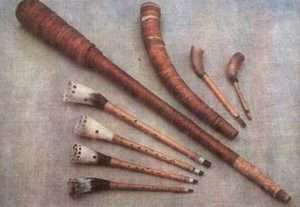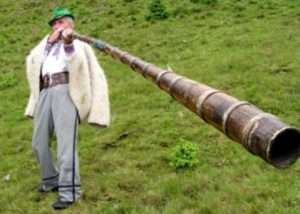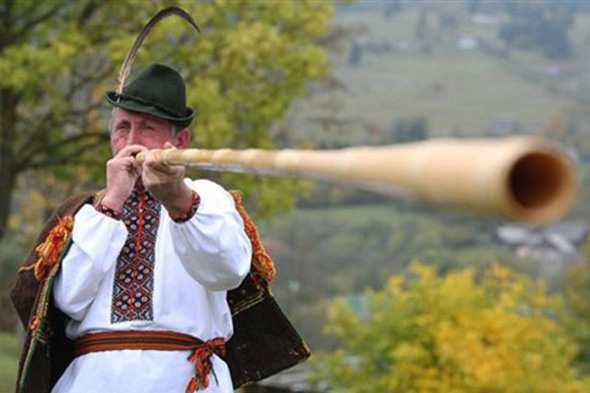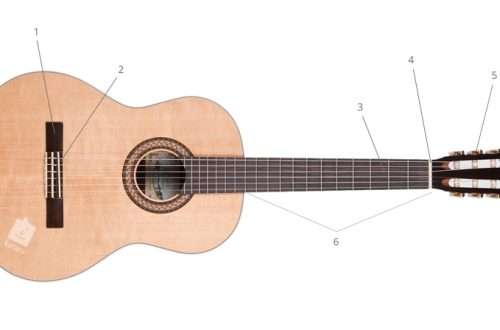
History of trembita
Trembita – wind mouthpiece musical instrument. It occurs in Slovenian, Ukrainian, Polish, Croatian, Hungarian, Dalmanian, Romanian peoples. Widely known in the east of the Ukrainian Carpathians, in the Hutsul region.
Device and manufacturing
Trembita consists of a 3-4 meter wooden pipe that does not have valves and valves. It is considered the longest musical instrument in the world. The maximum size is 4 meters. Diameter 3 cm, expands in the socket. A beeper is inserted into the narrow end, in the form of a horn or metal neck. The pitch of the sound depends on the size of the beeper. The upper register is most often used to play a melody. Trembita is a folk instrument of shepherds.
It is noteworthy that in order to obtain a unique sound, in the manufacture of the instrument, tree trunks are used that were struck by lightning. There are many legends associated with this. The Hutsuls say that the voice of the Creator is transmitted to the tree along with thunder. They also say that the soul of the Carpathians lives in it. The craftsmanship of making tools is owned only by craftsmen. A tree that is at least 120 years old is cut and left to harden for a whole year.  The most difficult process: the trunk is cut in half, and then the core is manually extruded, this stage can take a whole year. The result is trembita, which has a wall thickness of only a few millimeters and a length of 3-4 meters. For gluing the halves, birch glue is used, you can wrap it with bark, birch bark. Despite its impressive size, the instrument weighs about one and a half kilograms. Listed in the Guinness Book of Records as the longest wind instrument. In Polissya there is a shortened trembita, 1-2 meters long.
The most difficult process: the trunk is cut in half, and then the core is manually extruded, this stage can take a whole year. The result is trembita, which has a wall thickness of only a few millimeters and a length of 3-4 meters. For gluing the halves, birch glue is used, you can wrap it with bark, birch bark. Despite its impressive size, the instrument weighs about one and a half kilograms. Listed in the Guinness Book of Records as the longest wind instrument. In Polissya there is a shortened trembita, 1-2 meters long.
Trembita is an amazing musical instrument, the sound of which is heard for tens of kilometers. It can be used as a barometer. The shepherd can tell by the sound what the weather will be like. Especially brightly the instrument feels a thunderstorm, rain.
Hutsul shepherds use trembita instead of phone and watch.  It informs about the beginning and end of the working day. In ancient times, it was a means of communication between the shepherd and the village. The shepherd informed fellow villagers about the place of grazing, the arrival of the herd. A special system of sounds saved from danger, warning people at a distance of many kilometers. During wars, trembita was a signal instrument. The sentinels were placed on the tops of the mountains and relayed messages about the approach of the invaders. Trembita sounds saved lost hunters and travelers, indicating the place of salvation.
It informs about the beginning and end of the working day. In ancient times, it was a means of communication between the shepherd and the village. The shepherd informed fellow villagers about the place of grazing, the arrival of the herd. A special system of sounds saved from danger, warning people at a distance of many kilometers. During wars, trembita was a signal instrument. The sentinels were placed on the tops of the mountains and relayed messages about the approach of the invaders. Trembita sounds saved lost hunters and travelers, indicating the place of salvation.
Trembita is a folk instrument that accompanied the inhabitants of the Carpathians all their lives. She announced the birth of a child, invited to a wedding or a holiday, played shepherd melodies.

Trembita in the modern world
With the advent of new types of communication, the functions of modern trembita have become little in demand. Now it is primarily a musical instrument. It can be heard at ethnic music concerts as part of orchestras. In mountain villages, it is sometimes used to announce the arrival of important guests, the beginning of the holiday. In the Carpathian Mountains, the ethnographic festival “Trembitas Call to Synevyr” takes place, where you can hear the performance of shepherd melodies.





